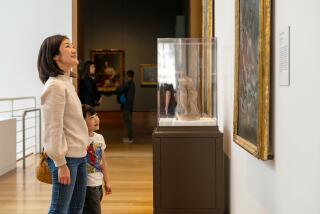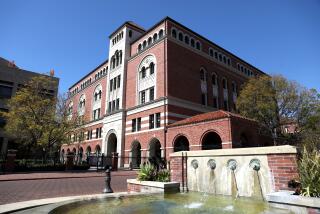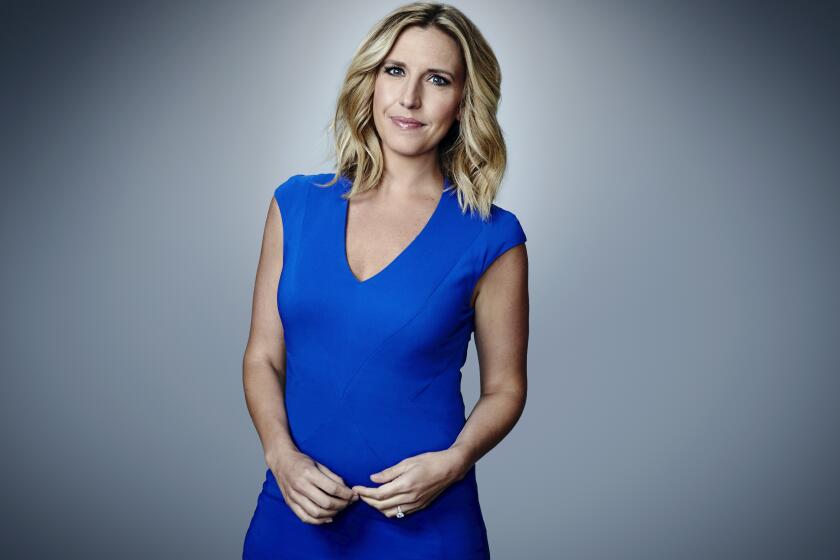LACMA Chinese art curator Yu Yu to lead USC Pacific Asia Museum
This story has been corrected. Please see below for details.
Christina Yu Yu made a great leap eastward in 1998 from her native China to a college campus in Massachusetts. This summer she will make a somewhat smaller one: She’s leaving the Los Angeles County Museum of Art, where she has been a curator of Chinese and Korean art since 2011, to become director of the USC Pacific Asia Museum in Pasadena.
When she starts her job Aug. 1, Yu Yu will be the first director of the Pacific Asia Museum’s new era under USC, not counting interim director Selma Holo, who has run two museums since December and will resume focusing on her longtime job as director of the on-campus Fisher Museum of Art.
USC took over the financially struggling Asia Pacific Museum late last year after its board had approached the university for help. Founded in 1971, the museum, which displays Asian art from all eras and regions, has a collection of more than 15,000 works, and 9,600 square feet of galleries housed in a historic 1920s replica of a Chinese palace. The museum’s annual budgets as an independent operation typically were less than $2 million.
Yu Yu “is the right leader to ensure that [the museum] reaches new heights as part of USC Arts,” Elizabeth Garrett, the university’s provost, said Thursday in a written announcement of her hiring.
Like the Fisher Museum, which displays art of the Americas and Europe, the USC Pacific Asia Museum is the equivalent of an academic school or division, with the directors comparable to deans who report to the provost, USC’s top academic administrator.
Yu Yu said that she’d been immersed in her curatorial work in the department of Chinese and Korean art that LACMA had launched when it hired her and department head Stephen Little as curators in 2011. She had not thought of becoming a museum administrator, let alone a museum director, until USC approached her about applying for the job.
“I always wanted to do curatorial work, using exhibitions and displays as a way to communicate ideas to people, until this came up,” she said. While the new job will mean largely setting aside the research and hands-on mounting of exhibitions that come with being a curator, Yu Yu said she was intrigued by the chance to forge links between the museum and the university’s academic departments and course offerings.
USC has a number of special programs and institutes focused on Asian and Asian American culture and history, and sees the museum as an asset in its emphasis on strong connections with Asia and the Pacific Rim.
Yu Yu said her first big task will be managerial: finding and hiring the next chief curator, who will work alongside curator Yeonsoo Chee, a holdover from the museum’s pre-USC days.
The new director said her role will be to set an overall strategic direction for exhibitions, leaving it mainly to the curators to “take a leading role in [generating] the ideas and themes and [deciding] what kinds of works will go into an exhibition.”
“It’s great to see Christina use her talent to take on the challenge of leading an institution,” LACMA director Michael Govan said in a written statement. “And I’m especially happy to have her continue to be a colleague in Los Angeles. We’re already discussing collaborative projects.”
Yu Yu said she will stay at LACMA to see its current exhibition, “Chinese Paintings From Japanese Collections” through to its July 6 closing; she said that many of the works on display need to be taken down after four weeks and replaced by others, because they are delicate pieces on silk or paper that are up to 1,000 years old and are extremely sensitive to light.
Los Angeles Times art critic Christopher Knight hailed the exhibition, curated by Little and Yu Yu, as “a magnificent show” and “something of a coup” because Japanese museums typically are reluctant to send major works abroad.
Yu Yu said it was the first big special exhibition that she and Little had originated since they began together at LACMA, their first years having largely been taken up with setting up new galleries for the museum’s Chinese art holdings.
Yu Yu said she had not been considering a career in art when she arrived in America as a freshman at Wellesley College in Massachusetts. But she became intrigued while working at the college’s Davis Museum and Cultural Center and decided to major in art history. She went on to earn a master’s degree from Boston University and a doctorate from the University of Chicago, where she focused on the art of the Yuan Dynasty, which began in China in the 1200s under the rule of the emperor Kublai Khan.
Before coming to LACMA, Yu Yu had worked 10 years for Chambers Fine Art, a New York City commercial gallery that opened a branch in Beijing. After her academic training in traditional Chinese art, she said, working for the gallery gave her an immersion in China’s contemporary art scene, along with “a comprehensive understanding of how to put up an exhibition.”
One of Yu Yu’s lasting contributions to LACMA was shepherding its April purchase of “Long March Restart,” by Chinese video artist Feng Mengbow. It’s a huge video game projection, not yet on display, that viewers will be able to play using a remote control device. They’ll manipulate its life-size hero, a Red Army soldier who dispatches monsters and demons by hurling cans of Coca-Cola at them. The Coke cans are significant, Yu Yu said, because the soft drink was the first Western consumer product introduced in China after it began to open up economically to the West in the late 1970s.
Although she has traversed many miles pursuing a career as an art scholar, there’s one journey Yu Yu said she is determined not to make -- a daily commute from her current home near LACMA to the Pacific Asia Museum.
“I really do not want to sit in my car for a couple of hours every day,” she said, so she will be hunting for a new place to live that’s close to her new job.
For the record 11:50 a.m.: An earlier version of this story incorrectly identified USC provost Elizabeth Garrett as Patricia Garrett.
More to Read
The biggest entertainment stories
Get our big stories about Hollywood, film, television, music, arts, culture and more right in your inbox as soon as they publish.
You may occasionally receive promotional content from the Los Angeles Times.







